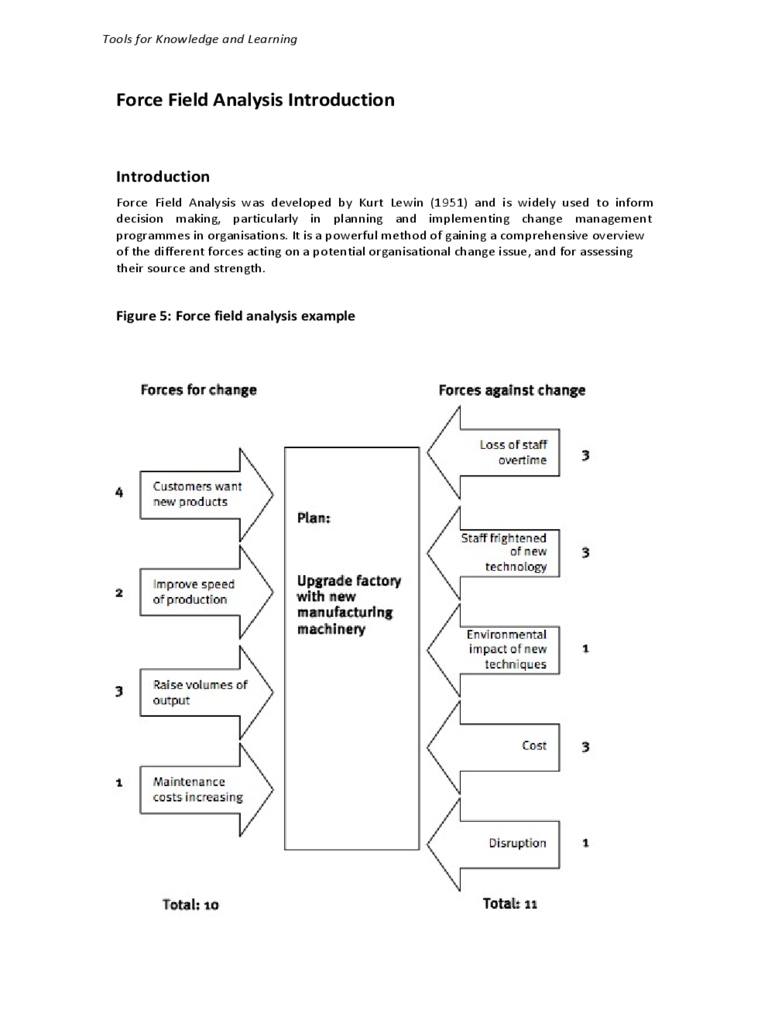Fillable Printable Force Field Analysis Example
Fillable Printable Force Field Analysis Example

Force Field Analysis Example

Force Field Analysis Introduction
Introduction
Force Field Analysis was developed by Kurt Lewin (1951) and is widely used to inform
decision making, particularly in planning and implementing change management
programmes in organisations. It is a powerful method of gaining a comprehensive overview
of the different forces acting on a potential organisational change issue, and for assessing
their source and strength.
Figure 5: Force field analysis example
Tools for Knowledge and Learning

Detailed description of the process
Force field analysis is best carried out in small group of about six to eight people using flipchart
paper or overhead transparencies so that everyone can see what is going on. The first step is to
agree the area of change to be discussed. This might be written as a desired policy goal or
objective. All the forces in support of the change are then listed in a column to the left (driving
the change forward), whereas all forces working against the change are listed in a column to the
right (holding it back). The driving and restraining forces should be sorted around common
themes and then be scored according to their ‘magnitude’, ranging from one (weak) to five
(strong). The score may well not balance on either side. The resulting table might look like the
example above (this figure comes from www.psywww.com/ mtsite/forcefld.html).
Throughout the process, rich discussion, debate and dialogue should emerge. This is an
important part of the exercise and key issues should be allowed time. Findings and ideas may
well come up to do with concerns, problems, symptoms and solutions. It is useful to record these
and review where there is consensus on an action or a way forward. In policy influencing, the
aim is to find ways to reduce the restraining forces and to capitalise on the driving forces.
Example: Food and Agriculture Organization of the United Nations
The Food and Agriculture Organization of the United Nations (FAO) adapted force field analysis,
adding an extra element of the organisation’s control over a situation. For example, in an
attempt to improve success in afforestation and reforestation programmes, the agency in
question might list all the driving forces and restraining forces. It then rates each force by its
importance and by the degree of control it exerts over that force. The totals are then calculated
and a table developed (Table 2). This means that for each force, the higher the total of
importance and control, the more impact the agency should have in trying to address that force.
In addition, if the agency can find some forces that explain others, the effectiveness of its actions
will be greater. For example, suppose that ‘improved operational planning’ can reduce ‘losses to
fires and grazing’ as well as ‘poor procedures for hiring and paying field workers’. Because it has
these cross-impacts, in this example, the agency decided to give special attention to ‘operational
planning’.
Table 2: Force field analysis for success in afforestation and reforestation programmes
Sources and further reading
• Hovland, I. (2005) Successful Communication: A Toolkit for Researchers and Civil
Society Organisations, ODI Working Paper 227, London: ODI.
• One case study comes from PLA Notes (1999) Issue 36, pp 17-23 from IIED,
• Another case details the use of force field analysis in a school situation to assess the
Management Techniques

potential to change from teacher-centred methods of working to greater pupil
participation in planning: www.crossroad.to/Quotes/brainwashing/force-field.htm.
• For original literature of force field analysis, see: Lewin, K. (1951) Field Theory in Social
Science, New York: Harper and Row.
• Simple step-by-step guides to carrying out force field analysis, with examples of the
use of force field analysis in management, see: www.mindtools.com/forcefld.html.
• Simple step-by-step guides to carrying out force field analysis, with examples of the
use of force field analysis in psychology, see: www.psywww.com/mtsite/forcefld.html.
• For a brief overview, see: mycoted.com/creativity/techniques/forcefieldanal.php.
• For computer software to conduct force field analysis, see:
www.skymark.com/resources/ tools/force_field_diagram.asp.
Tools for Knowledge and Learning



